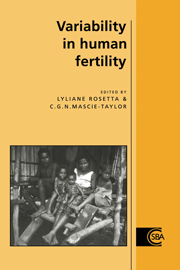Book contents
- Frontmatter
- Contents
- List of contributors
- 1 Introduction: the biological anthropological approach
- PART I HORMONAL ASPECTS OF FERTILITY REGULATION
- 2 The hypothalamo-pituitary regulation of the reproductive function: towards an increasing complexity
- 3 Lactation, condition and sociality: constraints on fertility of non-human mammals
- 4 Evidence for interpopulation variation in normal ovarian function and consequences for hormonal contraception
- PART II INTERPOPULATION VARIABILITY
- PART III METABOLIC AND ENERGETIC ASPECTS OF REGULATION
- Index
2 - The hypothalamo-pituitary regulation of the reproductive function: towards an increasing complexity
Published online by Cambridge University Press: 03 February 2010
- Frontmatter
- Contents
- List of contributors
- 1 Introduction: the biological anthropological approach
- PART I HORMONAL ASPECTS OF FERTILITY REGULATION
- 2 The hypothalamo-pituitary regulation of the reproductive function: towards an increasing complexity
- 3 Lactation, condition and sociality: constraints on fertility of non-human mammals
- 4 Evidence for interpopulation variation in normal ovarian function and consequences for hormonal contraception
- PART II INTERPOPULATION VARIABILITY
- PART III METABOLIC AND ENERGETIC ASPECTS OF REGULATION
- Index
Summary
For the historian of sciences, the state of knowledge on a specific biological topic may be viewed as a complex process characterized by an alternance of phases of accumulation of experiments and their corresponding results, respectively designed and discussed in a given paradigm, and phases when the scientific community is forced to revise the current paradigm and propose a new one more able to give a general framework for the interpretation of past and present data and design of future studies. The change to a new paradigm is frequently associated with the emergence of new tools and a change of scale in the understanding of the phenomena (Kuhn, 1970).
A similar analysis can be applied to our understanding of the reproductive axis. Schematically, the last two decades have been associated with the isolation of the three key structures involved in the reproductive axis in mammals, i.e. the gonads, the anterior pituitary and the hypothalamus and the identification of the roles, together with the description, of the urinary and plasma dynamic patterns of their principal secretions, and associated metabolites. The current period is characterized by both an internal and external complexification of the system. The internal complexification corresponds to a better understanding of the numerous intermediate steps involved in the response to an hormonal stimulus eventually resulting in another secretion by the stimulated cell.
- Type
- Chapter
- Information
- Variability in Human Fertility , pp. 7 - 24Publisher: Cambridge University PressPrint publication year: 1996



